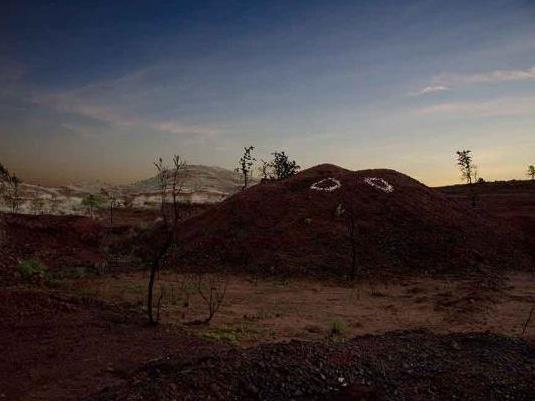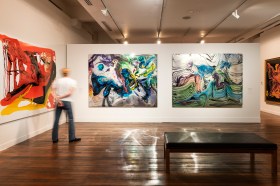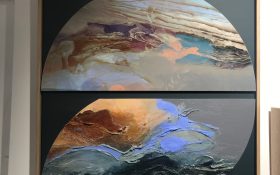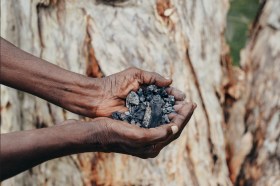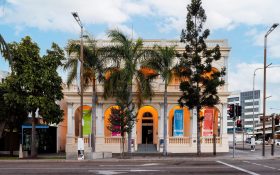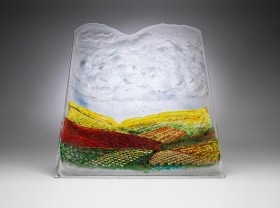Cliff Face digital photograph 2016 by Tarryn Gill via FORM.
Bedazzle is re-invention of a historical perspective for West Australians as well as a visual art exhibition.
On show at FORM’s inner city Perth gallery it takes the State’s gold rush as a point of departure for new contemporary art by three leading Western Australian artists developed through residencies in the Pilbara and Goldfields-Esperance regions. They were part of a residency program in one of the State’s hottest towns, Marble Bar and ran workshops with the local communities whilst developing their work.
The exhibition takes its name directly from the ‘Bobby Dazzler’ gold lump found in the 1890s in Marble Bar and recreated in this exhibition by Tarryn Gill. Words such as ‘darkly humorous’ and ‘gothic’ are used a lot in connection with this exhibition and in this case at least it’s justified. Gill’s work does pose some humorous questions in her soft-toy look alike foam sequined recreations of our most valuable commodity in this state obsessed with mining wealth.
However images of high school history classes spring to mind with the exhibition title. Both bestriding the exotic with its bedazzle elements and the prosaic with ‘Western Australia’s Gold Towns’ which we’ve heard numerous times how important they are to the mining industry, the economy and the politics of the state. So re-invention is no easy task. The artists are here exploring the legacy of the first of WA’s mining industry booms in towns such as Kalgoorlie-Boulder, Gwalia and Kambalda, Menzies and Coolgardie. And it would seem a fruitful topic for exploration. Right up front in the introduction we are reminded how history, migration and mining are connected as the originally free settler state of Western Australia asked to become a penal colony after only 25 years because it could not cope but the gold boom helped bring it to fruition; the rocks helped bring Western Australia to life.

The Pub digital photograph 2016 by Rebecca Dagnall
The standout works are by photographic artist Rebecca Dagnall who is also a PhD candidate at RMIT in Melbourne and known to explore the iconography of WA suburbia in previous works. Her works make you stop and stare and have their own authentic gothic tone simply because of the angles chosen, the manner in which the photographer works and where the photographer’s eyes alight; her intelligence gives it definition in its exploration of life and death and decay; truly gothic. In particular her work ‘The Gorge’ (80x120cm, 2016) which is engrossingly brooding as it makes you reconsider yourself in the landscape. It is beautiful yes, but in every rock face there is danger and potential loss. The dark sky faces down the rocks which have an evocative swell below. This work is a haunting remote landscape as described in the program.
Lynched (110x730cm, 2016 available as Pigment Print) and Claw (27x41cm, 2016 available as Pigment Print) also by Dagnell are part of a series of 3 works that turn your thoughts inward as she captures a dead kangaroo claw with its nails highlighted with the light emerging from the black background; is it coming back to life? Another of her works In a Barrel (27x45cm, 2016 available as Pigment Print) has an intrigue as you try to decipher what the dead insect bodies are. They have become abstracted arms, wings and legs, but look like praying mantis bodies floating or even flying in the water barrel reflections of this artfully constructed photograph. This theme of death continues in her Angel Cow (90x120cm, 2016, available as Pigment Print) work which is about the abject reality of decay as the cow is surrounded by its own mouth of matted blood but housed in a beautiful Victorian gold frame.
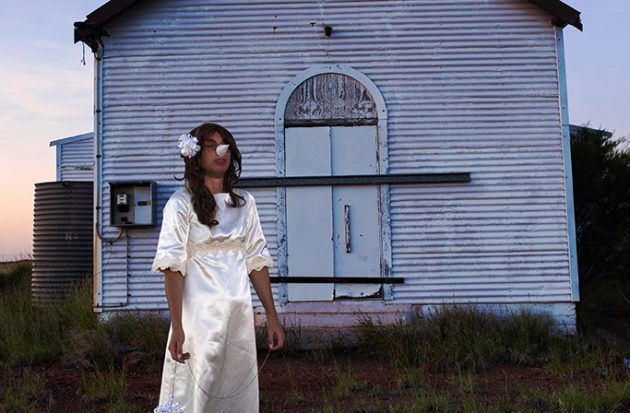
The Bride digital photograph 2016 by Dr Thea Costantino.
Dr Thea Costantino is an academic at Curtin’s School of Visual Arts and her practice encompasses drawing, sculpture, video, animation, photograph and costume design as well as works of fiction and non-fiction. Her works of creating false constructs in outback towns or what is called ‘staged portraits with indicators of disassociated states including masks’ are less successful. The contrivance of Bride (127x84cm, 2016 available as Giclee Print) and Cabbage Wife (127x82cm, 2016 available as Giclee Print) seem absurd with their white triangle noses on black faces. Are we content with a contrast of black and white to say this is sufficiently exploring identity? Mention is made of critiquing Australian nationalism and post-colonial history but there is more to juxtaposing contrary images for something to be a critique.
Tarryn Gill, a multidisciplinary artist from Perth has undertaken residencies in Australia and world-wide. She recreates some of the largest gold nugget finds in WA in her work The Golden Eagle (200x300cm, 2016 available as Phototech Print) and Bobby Dazzler (92x8x22cm, 2016 sculpture) which is a sculptural form of foam, sequins, sculpey and artificial eyes and false eye lashes that somehow are more disturbing than the eyes on this reconstructed lump of black ‘rock’ of gold. Gill also explores the personality of rocks in her series of Rock Guardians 1-8 (30.5×45.4cm, 2016) where she photographs the anthromorphic faces she finds in the rock-scape. These are the most direct of many of the works.
Dagnell’s works Lynched and Claw stay with me as she references those who died of heat exhaustion or killed by unidentified means in the goldfields towns seeking out gold that would hopefully change their lives, but not in that extreme manner that ultimately under-estimated the natural world around them.
Rating: 3.5 stars out of 5
Bedazzle: Photographing Western Australia’s Gold Towns
with work by Dr Thea Costantino, Tarryn Gill and Rebecca Dagnell
FORM GalleryPerth
22 July – 29 August 2016
